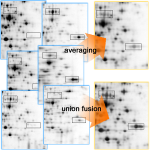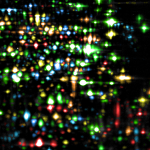Maps of Substances
GasPedal's image fusion lets you create maps of substances from collections of GCxGC images. A map of substances looks like a real GCxGC image but combines all spots into a single image – even those that will never be seen simultaneously. You can collect substance identifications on the map and use GasPedal to transfer them automatically and reliably from and to other images.
GasPedal allows you to place labels anywhere on a gel image – independently from spot locations. Managing master images with spot identifications is easy – a single click will transfer labels from one image to another. You can change label colors and formats according to your preferences. Just like any other data generated by GasPedal, label data is saved in XML files that can easily be processed by other applications.
Image Fusion

GasPedal's proprietary image fusion lets you create maps of substances from collections of GCxGC images. The respective images need to be aligned by image warping, another technology inside GasPedal. A map of substances looks like a real GCxGC image but shows all spots on a single image - even those that will never be seen at the same time. You can collect substance identifications on the map and then use GasPedal to automatically and reliably transfer them to new images. GCxGC images can also be merged into an average image which combines replicates pixel-by-pixel.
Color Coding

The larger an experimental design, the higher the analytical complexity. Spot color coding condenses whole experiment spot profiles by using different colors in just one GCxGC image, typically the Map of Substances of your experiment since it includes the complete spot pattern.
Having viualized spot sets in different colors simplifies extraction of the really interesting spots.
Read more about Proteome Maps in the article
Luhn, S., Berth, M., Hecker, M., & Bernhardt, J. (2003).
Using standard positions and image fusion to create proteome maps from collections of two-dimensional gel electrophoresis images.
Proteomics, 3(7), pp. 1117-1127.
which has been published in the peer reviewed journal Proteomics.
